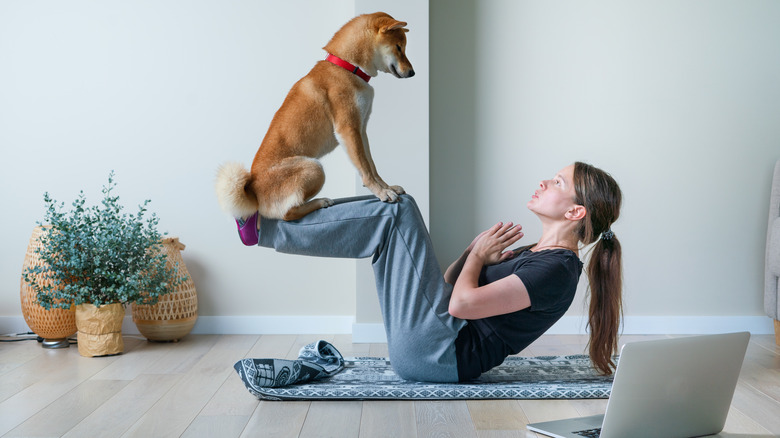Incidental Exercise Can Help You Squeeze In A Workout On The Busiest Days
No matter how insanely busy your schedule is, you should always prioritize regular physical activity. It's easy to let the days pass by hunching over your computer, and you probably don't need any more reminding that a sedentary lifestyle can have an adverse impact on your overall well-being. According to the Department of Health and Human Services, adults need to clock in a minimum of 150 minutes of "moderate-intensity physical activity" or 75 minutes of intense exercise every week to be in tip-top shape, per the Centers for Disease Control and Prevention.
If weight loss is your goal, you'll need to do considerably more to see noticeable results. It also helps to engage in strength training exercises to enhance your endurance and flexibility. It's worth noting that 150 minutes spread across one week is only roughly 22 minutes per day, which, in retrospect, doesn't seem like much. But even so, many still find it challenging to squeeze time for exercise into their day due to various commitments. If you happen to be time-poor, one hack is some incidental exercise. In fact, you may already be doing it without even realizing it.
What is incidental exercise?
Incidental exercise is exactly what it sounds like. Instead of signing up for a gym membership or carving time out of your busy schedule to sweat it out for lengthy periods, incidental exercise involves performing physical activities in short bursts throughout the day, including at home, so you can still log your weekly workout minutes without making much of a commitment at all, or even thinking too hard about it.
Dr. Simoné Laubscher, the founder of Rejuv Wellness, explains that it can be as "simple as getting off of the bus a few stops earlier and walking, increasing your speed when you're walking to the shops, bounding up the stairs instead of walking, or squatting while you're waiting for the kettle to boil" (via Country & Town House). You don't have to think too much about the moves you make as long as you're actually moving.
"Investing in a mini-trampoline and doing 100 mini bounces at various points throughout the day to change your state and shake off stress is a great approach to weaving incidental exercise into your life," Dr. Laubscher added. In a nutshell, incidental exercise is any physical activity weaved into your daily routine without the added pressure of committing to a certain time or doing traditional fitness activities.
How to practice incidental exercise
There's no rule book that outlines how to properly do incidental exercise, but Emmanuel Stamatakis, a Professor of Physical Activity, Lifestyle, and Population Health at the University of Sydney, confirmed to ABC Australia that any activity that gets your heart racing counts. "Use each and every opportunity in daily living to get out of breath. That's the key thing," he explained. "Getting out of breath and raising the heart rate, even if it's for 30 seconds or a minute."
What's more, Ken Nosaka, Director of Exercise and Sports Science at Edith Cowan University, shared that frequency is just as important. Even though incidental exercises are unconventional, he noted that it's still more effective doing "more frequent exercises than doing a large volume of exercise once a week" (via Inverse). This means that you have to incorporate as many movements into your daily routine as you can instead of only moving around every once in a while.
You could try climbing the stairs quickly instead of using the elevator, parking your car farther from an establishment to get more steps in on the walk to and from it, or even performing walking sprints. Something as simple as jogging in place for a few minutes at a time can help. The most crucial part, though, is staying consistent. As long as you make an effort to keep moving, no matter how you do it, you'll be healthier and feel better overall.


